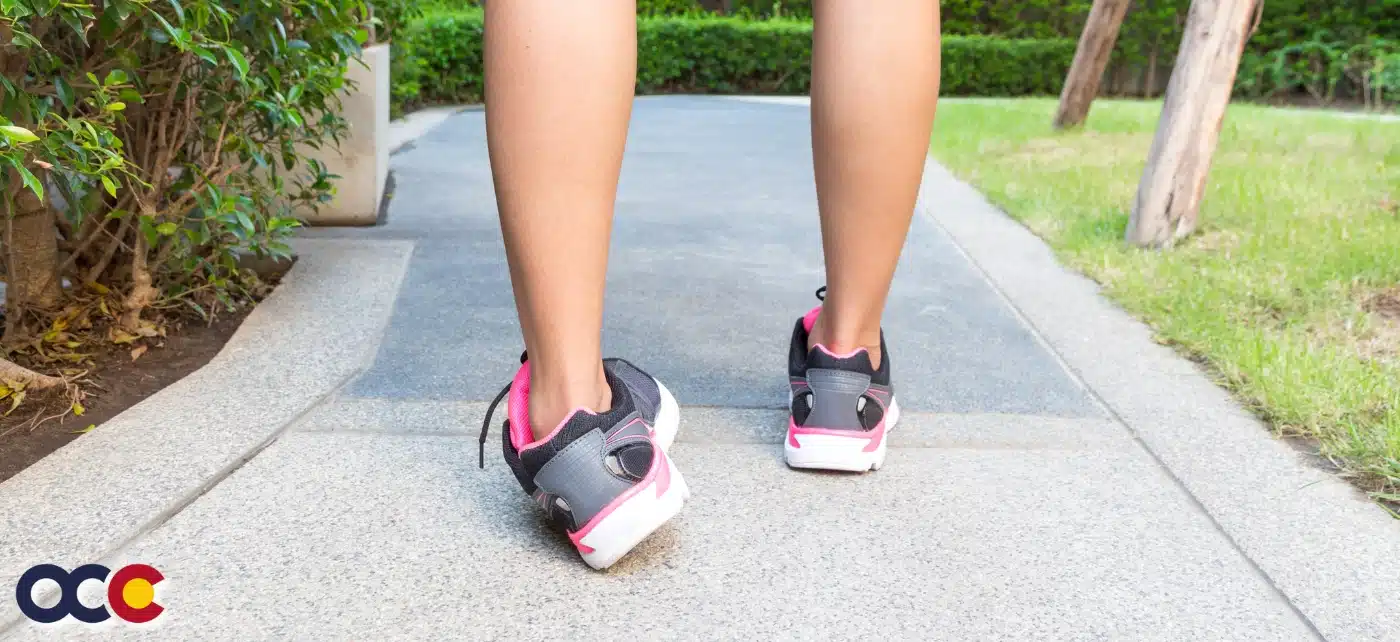Walking is something everyone takes for granted. However, pain on the outer side of the ankle, which can be chronic or ongoing ankle pain, can lead to instability, limitations, arthritis, and tendon problems. Chronic lateral ankle pain on the outside of the ankle may be so intense that not just walking but participating in sports becomes problematic. While chronic lateral ankle pain often develops after an injury, such as a sprained ankle, several other conditions may cause it. That’s why the place to start is at OCC – Advanced Orthopedic & Sports Medicine Specialists in Denver, Parker, or Aurora, Colorado, where you’ll get the very best care possible.
OVERVIEW
Chronic lateral ankle pain is lasting pain on the outer side of the ankle that often develops after an injury, such as a sprain or fracture of the ankle where there is a failure of the ankle to heal properly. An ankle sprain refers to the tearing of the ligaments of the ankle. Ligaments are bands of tissue—like rubber bands—that connect one bone to another and bind the joints together. In the ankle joint, ligaments provide stability by limiting side-to-side movement. The most common ankle sprain occurs on the lateral (outside) part of the ankle. There’s a good chance one might have sprained the ankle at some point while playing sports or stepping on an uneven surface — some 25,000 people sprain their ankle every day. Almost half of all people who sprain their ankle once will experience additional ankle sprains and recurrent chronic lateral ankle pain. Ankle sprains that can lead to chronic lateral ankle pain occur among people of all ages and at all activity levels; in fact, they are the number one reason for missed participation in athletics. Up to 40% of ankle sprains go on to develop chronic lateral ankle pain.
ABOUT THE ANKLE
The ankle is a complex mechanism. It is the joint that connects the foot to the lower leg. Healthcare providers sometimes refer to it as the tibiotalar joint or the talocrural joint. What is normally thought of as the ankle is actually made up of two joints: the subtalar joint and the true ankle joint. The true ankle joint is composed of three bones: the tibia, which forms the inside, or medial, portion of the ankle; the fibula, which forms the lateral or outside portion of the ankle; and the talus underneath. The true ankle joint is responsible for the up-and-down motion of the foot. Beneath the true ankle joint is the second part of the ankle, the subtalar joint, which consists of the talus on top and the calcaneus on the bottom. The subtalar joint allows side-to-side motion of the foot. These components of the ankle, along with the muscles and tendons of the lower leg, work together to handle the stress the ankle endures when walking, running, and jumping.
WHAT IS CHRONIC LATERAL ANKLE PAIN?
Chronic lateral ankle pain refers to persistent pain on the outer side (lateral) of the ankle that lasts for an extended period of time. The most common cause of chronic lateral ankle pain is incomplete healing after an ankle sprain. When the ankle is sprained, the connecting tissue between the bones is stretched or torn. Even with thorough and complete rehabilitation, the ligament or surrounding muscles may remain weak, resulting in recurrent instability. Poor strength or flexibility in the ankles may increase the risk of a sprain when participating in sports. Shoes that don’t fit properly or aren’t appropriate for an activity, as well as high-heeled shoes in general, make ankles more vulnerable to injury. As a result, one may experience additional ankle injuries.
CAUSES
Other causes of chronic lateral ankle pain include:
- An injury to the nerves that pass through the ankle. The nerves may be stretched, torn, injured by a direct blow, or pinched under pressure (impingement)
- Peroneal tendon disorders: a torn or inflamed tendon
- Both osteoarthritis and inflammatory arthritis of the ankle joint
- A break (fracture) in one of the bones that make up the ankle joint
- An inflammation of the joint lining (synovium)
- The development of scar tissue in the ankle after a sprain takes up space in the joint, thus putting pressure on the ligaments
- Severe flatfoot deformity
- Referred pain: pain from other structures, such as the lower leg or foot, can sometimes be felt on the lateral side of the ankle
SYMPTOMS
- Pain on the lateral side of the ankle is a constant dull ache
- Pain may be so intense that one has difficulty walking or participating in sports
- Difficulty walking on uneven ground or in high heels
- A feeling of giving way (instability)
- Swelling
- Stiffness
- Tenderness
- Repeated ankle sprains
NON-SURGICAL TREATMENT
Treatment will depend on the final diagnosis and should be personalized to individual needs. Non-surgical treatments for chronic lateral ankle pain include:
- Over-the-counter anti-inflammatory medications such as aspirin or ibuprofen to reduce pain and swelling
- Physical therapy to stabilize muscles, improve joint flexibility, and improve strength
- Immobilization with an ankle brace or other support
- Steroid injections
WHEN IS SURGERY INDICATED?
If the condition requires it, or if more conservative treatment options don’t bring relief, surgery may be recommended. The type of surgery would be determined based on the cause of the continued chronic pain. Some procedures use arthroscopic techniques; others require open surgery. Surgical treatment options include:
- Removing (excising) loose bone fragments
- Cleaning (debriding) the joint or joint surface
- Repairing or reconstructing loosened or stretched ligaments which leads to a condition called chronic ankle instability
- Transferring tendons
GETTING THE RIGHT DIAGNOSIS. GETTING THE RIGHT DOCTOR.
Because there are so many potential causes for chronic lateral ankle pain, you need an orthopedic specialist with extensive skill and experience in pinpointing the exact source of the pain. The surgeons at Advanced Orthopedics in Denver, Parker, or Aurora, Colorado, will go into great detail to ensure they arrive at a diagnosis that leads to the best, most appropriate treatment plan with the best outcome. Therefore, a variety of imaging such as X-rays, CT scans, MRIs, or bone scans may be ordered to differentiate between potential conditions that may be causing your chronic lateral ankle pain. Part of their skill is in the interpretation of these images to ensure you get the best outcome and the pain is relieved. Not only are the experts at Advanced Orthopedics experienced and thorough, they care about getting you back to life as usual. If you are suffering from chronic lateral ankle pain, schedule an appointment today.










